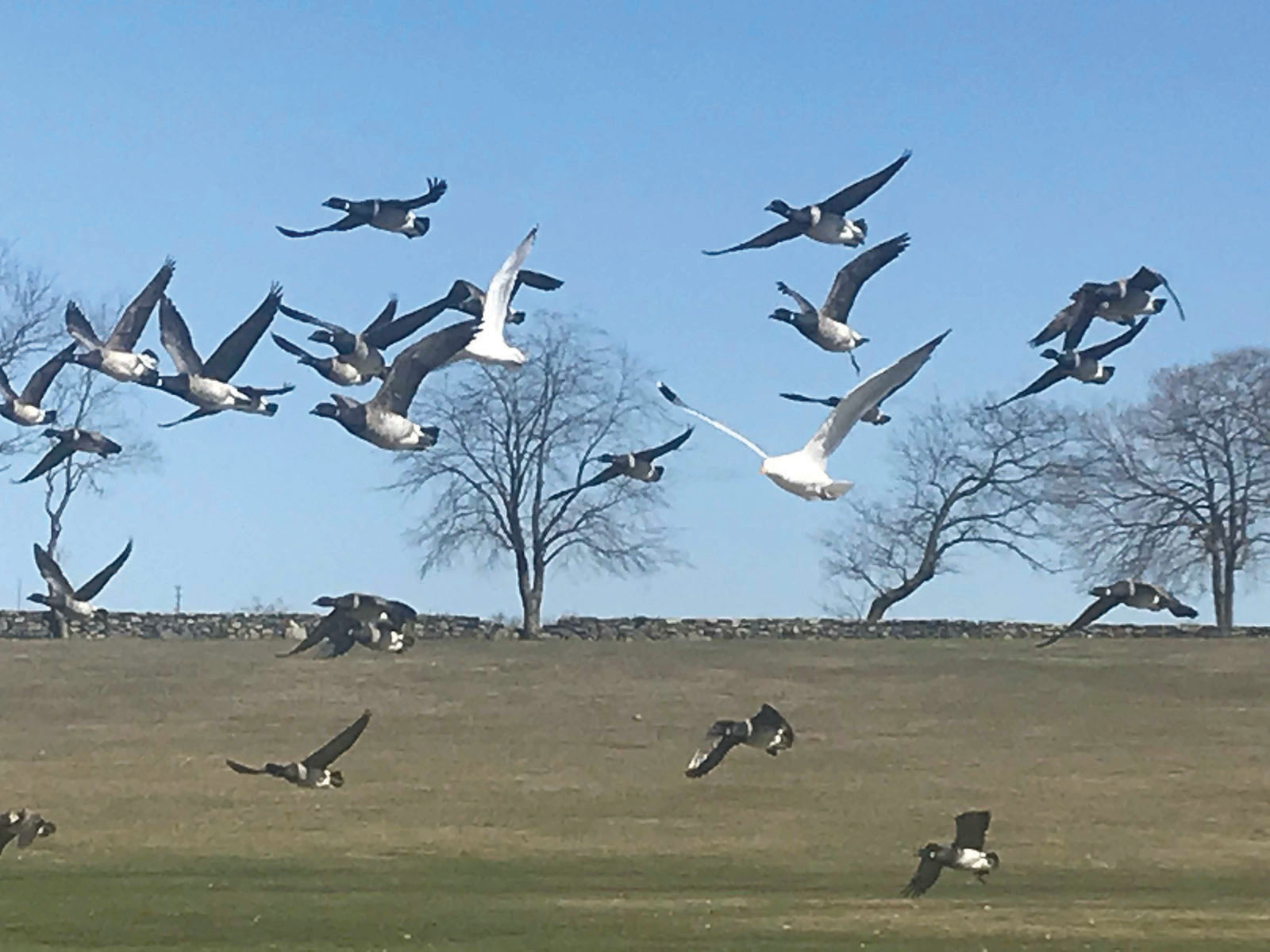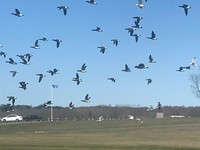Brant linger to chatter and feed on Colt Park's ‘poor grub’
RI’s ‘true goose’ has yet to fly north for summer nesting
p.p1 {margin: 0.0px 0.0px 0.0px 0.0px; font: 24.0px 'Times New Roman'} p.p2 {margin: 0.0px 0.0px 0.0px 0.0px; font: 24.0px 'Times New Roman'; min-height: 27.0px} p.p3 {margin: 0.0px 0.0px 0.0px …
This item is available in full to subscribers.
Please log in to continue |
Register to post eventsIf you'd like to post an event to our calendar, you can create a free account by clicking here. Note that free accounts do not have access to our subscriber-only content. |
Day pass subscribers
Are you a day pass subscriber who needs to log in? Click here to continue.
Brant linger to chatter and feed on Colt Park's ‘poor grub’
RI’s ‘true goose’ has yet to fly north for summer nesting
p.p1 {margin: 0.0px 0.0px 0.0px 0.0px; font: 24.0px 'Times New Roman'} p.p2 {margin: 0.0px 0.0px 0.0px 0.0px; font: 24.0px 'Times New Roman'; min-height: 27.0px} p.p3 {margin: 0.0px 0.0px 0.0px 0.0px; line-height: 14.0px; font: 12.0px Courier} p.p4 {margin: 0.0px 0.0px 0.0px 0.0px; line-height: 14.0px; font: 12.0px Courier; min-height: 11.0px} p.p5 {margin: 0.0px 0.0px 0.0px 0.0px; line-height: 14.0px; font: 24.0px 'Times New Roman'; min-height: 27.0px} p.p6 {margin: 0.0px 0.0px 0.0px 0.0px; font: 24.0px 'Times New Roman'; color: #232323} span.s1 {font-kerning: none} span.s2 {font-kerning: none; color: #232323}
CAPTIONS
Brant take flight at Colt State Park. Note Sen Chafee statue at right.
Several seagulls join the brant in flight.
Brant feeding on lawn grass at Colt State Park.
If you are a winter birder driving through Colt State Park, you have surely seen the many brant gathered in the shallows or feeding on open expanses of lawn.
Numbering up to 1,000 at times, the flock of winter geese has favored the Mill Gut outflow around North Point and along the rocky western shoreline. More recently they are feeding in the open grassy area west of Sen. John Chafee’s statue.
But if you are curious to see them at this point, you’d better hurry before they take off and return to summer habitats in their Arctic nesting area.
Rhode Island’s “true goose,” according to local birder Ray Payson, brant is entertaining to watch feeding and chasing one another away from a preferred spot. Occasionally they appear to march in brief unison.
“I really enjoy hearing their chatter when feeding, and I love seeing them fly,” Mr Payson said. “They look like a goose, but they fly like a duck.”
In the next few weeks they will begin their northern migration, flying in ragged formation, at times several thousand feet high. The colder winter has kept them around longer this year, but approaching warm weather is their cue to leave.
Jason Major of RI Bird Hunter said brant usually are headed back north by now, but this year’s cold has delayed migration. Over the next week we’ll see less of them, and by mid-May they’ll be gone. “For me,” Mr Major said, “it’s a little sad because they bring a nice sociability to the coves along the Bay.
Smaller than Canada geese, brant have more distinctive markings. One URI website notes brant measure 25 inches long, are dark colored with a black head, neck and breast. White patches show on both sides of the neck, just under the throat. The body underside is gray, lightening to white at the tail, with a black bar at its end. Juveniles lack the white neck pattern.
The main food sources for brant are eelgrass (80 percent), aquatic plants, moss, lichen, crustaceans, mollusks, worms, insects, and some grain. They feed like ducks, dipping from the surface into submerged vegetation. In recent years, however, their feeding habits have changed.
“The brant is the goose the Native American would have seen in great numbers here and around Narragansett Bay,” Mr. Payson said. “They would have feasted on eelgrass, but now must settle for our current algae-like sea lettuce, seaweeds and Colt State Park lawn grass.”
Bristol native and waterfowl expert Matthew Perry recently expressed sympathy for the Colt Park brant, noting they only came out of the water to feed on lawns in the late 1970s. He said brant were typically seen in Massachusetts and Rhode Island only during migration, and were most common in New Jersey and mid-Atlantic states (MD, DE, VA) during winter. Now many of them choose to winter in our state.
“We can feel sorry for them, since the lawns make for poor grub,” Mr. Perry said. They started feeding on lawns due to the frozen salt water throughout the eastern United States. Before then they were not seen feeding out of water, he said.
Eel grass was essentially wiped out by an unknown disease in the 1930s, Mr. Perry said, adding that Canada geese started field feeding in the 1960s. Both species adapted to human habitats when their own food was degraded.
Mr. Perry said the blight that killed eel grass in the early 1900s greatly reduced the brant population. In the late 1970s the prolonged cold winters froze saltwater habitat in New Jersey to Virginia, and Mr. Perry estimated more than 50,000 died in New Jersey from starvation. Those that survived did so because they went on shore and grazed on lawns in suburban areas. That was the beginning of feeding on land .
Brant are in some ways more discriminating than humans. A scientist with the USGS Patuxent Wildlife Research Center in Maryland, Mr. Perry notes that geese can detect fertilized lawns from those that are not. “Their feedback mechanism is very fast,” he said. “I did experiments and found they will change to a better diet within minutes. We humans rely more on taste than nutrient quality.”
Seekonk means black goose, according to Mr. Payson, from the “kronk” sound these geese make, which he said is usually heard first before the birds are seen. He said his first sighting of Brant in Bristol was in the early 1980s when they re-discovered Narragansett Bay.
A URI website notes that brant is derived from the German word “brand,” meaning burnt, referring to its dark feathers, and the species name “bernicla” is from the Norwegian word for barnacle. An ancient legend is that brant hatch from barnacles on driftwood.
Brant fly with rapid beats on long, pointed wings and in a ragged formation. Flocks do not form a “V” shape as some geese. They bunch together or form long wavy lines. They return to the same nesting site every year and form lifelong pair bonds at three years of age.
Retired from construction work, local bird enthusiast Carl Russo said he has “an abiding interest in birds” that he has shared for many years with Mr. Perry. He said he misses seeing and hearing the ground nesting birds like the ring-necked pheasant and meadowlark he used to see in large numbers. Now he watches brant.
“I’m not necessarily enthused with them,” he said. “It’s just that there are so many of them.” He said he drives out to Colt State Park about four mornings a week at about 7:30 to watch them chase each other around for about a half-hour. “Warm weather is coming,” he said. “I think they will be gone soon.”









